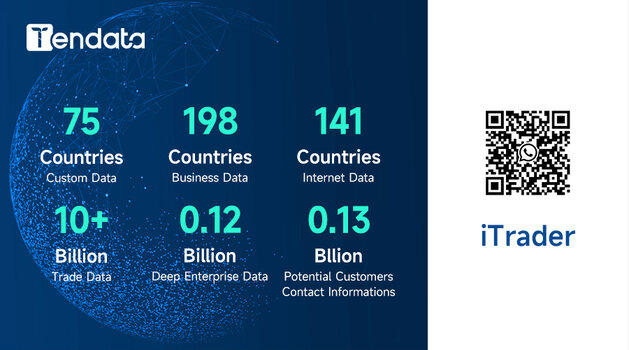 Export News
Export News
 2023-09-27
2023-09-27
The trade relationship between Kenya and Uganda is significant, reflecting the East African Community's (EAC) goal of promoting economic integration and cooperation among member states. Kenya, being one of East Africa's economic powerhouses, exports a variety of products to Uganda. In this article, Tendata will delve into what Kenya exports to Uganda, examining the key goods and factors driving this trade relationship.
>>>Increase Company Revenue with Tendata<<<

Kenya's Exports to Uganda
Kenya exports a diverse range of products to Uganda, with some of the major exports being:
· Manufactured Goods: Kenya supplies Uganda with various manufactured products, including processed foods, textiles, and cement. Processed foods such as dairy products, biscuits, and beverages are particularly popular among Ugandan consumers.
· Agricultural Products: Kenya's agricultural sector plays a pivotal role in exports to Uganda. Maize, wheat, and other cereals are often exported to meet Uganda's food demand. Additionally, Kenyan vegetables, fruits, and processed fruit juices are also in high demand.
· Petroleum Products: Kenya exports petroleum products, including petrol, diesel, and lubricants, to Uganda. Uganda relies on imports to meet its domestic petroleum needs.
· Construction Materials: Uganda's growing construction industry creates a demand for construction materials such as steel, cement, and roofing materials. Kenya is a key supplier of these materials.
· Pharmaceuticals and Medical Supplies: Kenyan pharmaceutical companies export a range of medicines, medical equipment, and supplies to Uganda's healthcare sector.
Factors Driving Kenya's Exports to Uganda
Several factors contribute to Kenya's strong export presence in Uganda:
· Proximity: Kenya and Uganda share a long border, making it logistically convenient to transport goods between the two countries.
· Trade Agreements: Both countries are members of the East African Community (EAC), which promotes regional trade and cooperation. The EAC's elimination of non-tariff barriers facilitates the movement of goods.
· Diverse Economy: Kenya's diverse economy allows it to produce a wide range of goods, catering to Uganda's diverse needs.
· Infrastructure: Kenya has invested in road and rail infrastructure, improving connectivity and facilitating trade with its neighbors.
Challenges and Trends
While the trade relationship between Kenya and Uganda is robust, it faces challenges and is influenced by global trends:
· Non-Tariff Barriers: Despite regional trade agreements, non-tariff barriers, such as customs delays and differing regulations, can hinder trade flow.
· Quality Standards: Meeting quality and safety standards is crucial, especially in the food and pharmaceutical sectors, to ensure the continued export of goods to Uganda.
· COVID-19 Impact: The COVID-19 pandemic disrupted trade flows, highlighting the need for resilient and adaptive supply chains.
· Sustainable Trade: Both countries are increasingly focused on sustainable trade practices, including environmentally friendly agriculture and responsible sourcing.
· Digital Trade: The growth of e-commerce and digital trade presents opportunities for Kenya and Uganda to expand their exports in the digital economy.
Conclusion
Kenya's exports to Uganda play a vital role in strengthening economic ties and fostering regional integration within the East African Community. As both countries continue to invest in infrastructure and adapt to global trade trends, the trade relationship is likely to grow, benefiting businesses and consumers on both sides of the border. However, addressing challenges such as non-tariff barriers and quality standards will be essential to sustain and expand this trade partnership.
Customer development is always a primary focus for us in international trade. Having customers leads to orders. But if we're looking to start a business or expand our development channels, what are the available avenues for customer development? And what are the characteristics of these customer development channels?
The traditional undifferentiated marketing approach mostly involves extensive investment to achieve broad coverage. In the Marketing 1.0 era (Industrial Age) and the Marketing 2.0 era (Internet Age), the marketing demand of companies is to precisely locate their target customers within a massive audience (or potential audience). They also need to understand the procurement-supply relationships, price ranges, purchasing frequency, and style preferences of these target customers. This is akin to finding a needle in a haystack.

Tendata can assist foreign trade enterprises in better customer development. Once a company has precisely targeted a market (or region) using Tendata's data, the next step is to further pinpoint high-quality customers within that market, creating customer "profiles" and filtering out target customers that match one's own supply capabilities. (>>>Click to Develop New Customers)
Category
Leave Message for Demo Request or Questions


 T-info
T-info T-discovery
T-discovery

 My
Tendata
My
Tendata Market Analysis
Market Analysis Customer
Development
Customer
Development Competitor
Monitoring
Competitor
Monitoring Customer Relationship
Customer Relationship





































































































































